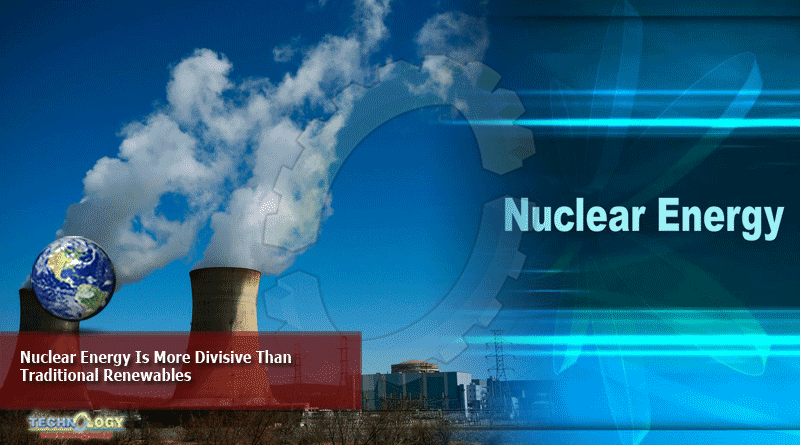Nuclear Energy Is More Divisive Than Traditional Renewables, Like Solar And Wind, And Polling Cites Two Reasons For This

Fear Of An Accident, & What To Do With The Waste.
There’s also the cost: financial-advisory firm Lazard estimated that nuclear plants cost significantly more to build than either wind or solar farms.
But what if there was a way around those problems? Bill Gates thinks he’s found one, and it’s called TERRAPOWER.
Founded by Gates in 2006, the company recently announced it plans to build small, advanced nuclear power stations across the United States. These nuclear power stations are remarkably different from anything currently in use. That’s because they rely on a new source of nuclear energy: a traveling wave reactor.
WHAT IS TERRAPOWER?
Aside from Gates’ involvement, the company has also picked up some funding from the US government, but Gates is listed on TerraPower’s website as the sole founder and chairman.
Despite being a decade old, the company hasn’t built anything, but that’s okay when you are owned by a billionaire there’s time to lay groundwork.
Alongside CEO Chris Levesque, CTO John Gilliend, and others, Gates is using TerraPower to investigate the potential of a traveling wave reactor to transform nuclear power — and perhaps rehabilitate its image.
TRAVELINGWHAT REACTOR?
To understand a traveling wave reactor, it’s important to understand how it differs from a traditional nuclear reactor. Most reactors today are “light water” reactors, and they operate by splitting uranium atoms to generate energy in a process known as fission.
Fission is a tricky process that doesn’t happen spontaneously in nature. That’s because uranium is made up of two isotopes, known as U-235 and U-238. While only 0.7 percent of uranium is U-235, this is the isotope the nuclear process needs to work. Enrichment artificially enhances the amount of U-235 within uranium, and it can reach as high as 20 percent concentration in weapons.
Enriched uranium is incredibly dangerous. That’s due to the ease with which it can be converted into a weapon, and because it can release toxic hydrofluoric acid when interacting with moisture.
After fission takes place, what is left is U-238, also known as “depleted uranium.” It has its own dangers, especially if ingested, and its uses, for example in radiation shields in medical equipment. But it is primarily waste. And, over time, its radiation levels increase, making it dangerous to keep around.
A traveling wave reactor would give depleted uranium a new lease of life — as fuel.
CAN A NUCLEAR REACTOR USE DEPLETED URANIUM AS FUEL?
A traveling wave reactor’s core, which TerraPower calls the technology’s “true innovation,” uses a mixture of U-235 and depleted uranium. Enriched uranium rods are surrounded by depleted uranium rods. Serving as what TerraPower describes as an “initiator,” the enriched uranium kickstarts the titular traveling wave reaction, “a slow-moving chain reactor of concentric waves of fission.”
Surrounding the reactor core are several sights that would be familiar in any nuclear reactor: a sodium coolant, and a fuel-handling machine to shuffle in new rods.
WHAT ARE THE ADVANTAGES?
According to TerraPower, there are many. They rest on the fact that a traveling wave reactor uses depleted uranium, which eliminates the need for what is known in nuclear-speak as “reprocessing” — the separation of plutonium and uranium from other elements of nuclear waste. Called “dangerous, dirty, and expensive” by the Union of Concerned Scientists, reprocessing all of the nuclear reactor fleets in America would cost over $4 billion.
TerraPower “eliminates the need for reprocessing,” which in turn “reduces proliferation concerns, lowers the overall cost of the nuclear fuel cycle, and helps to protect the environment by making use of a waste byproduct,” according to the company.
WHY HASN’T IT HAPPENED YET?
At first, TerraPower didn’t plan to build in the US. In 2015, the company inked a deal with the state-owned China National Nuclear Corporation to begin building an experimental traveling wave reactor outside of Beijing.
But the deal came with some serious complications: namely, politics. By January 2019, tensions were rising between China and the Trump administration, and US restrictions on technology deals with China forced the collapse of the deal.
“We’re regrouping,” CEO Chris Levesque told the Wall Street Journal at the time. “Maybe we can find another partner.”
Reflecting on the project’s collapse in a year-end letter, Gates wrote: “We may be able to build it in the United States. Nuclear energy
WHAT’S NEXT FOR TERRAPOWER?
The company’s new plan, which also involves new partner GE Hitachi Nuclear Energy, is to build a series of small traveling wave reactor plants across the US throughout the 2020s.
These plants, which the company calls Natrium, would not run full-time. Rather, they would act as a complement to established renewables, like solar and wind, only operating when those sources of energy can’t power an entire grid. If the other green energy sources are operating at full capacity, the plants would safely store their reactors in tanks of molten salt, ready to use when called upon.
TerraPower estimates that each Natrium plant would cost $1 billion each to build. That price is still stubbornly high. But, again, this is where it helps to have a billionaire founder.
This news was originally published at inverse.com
